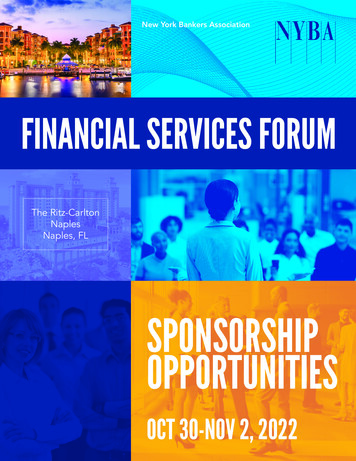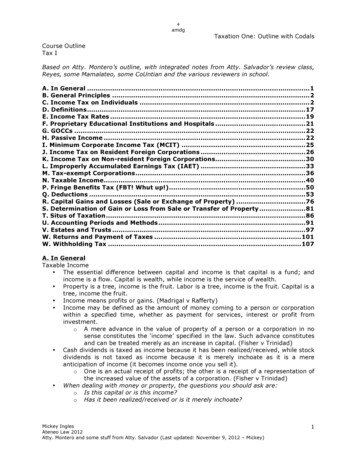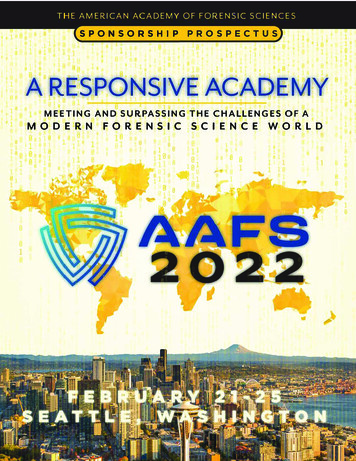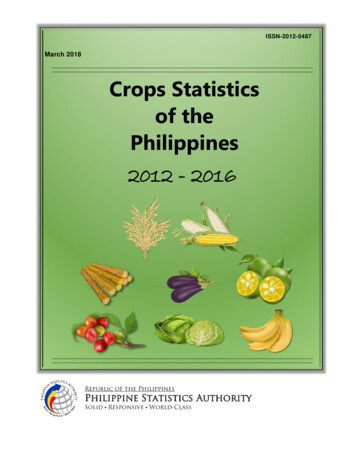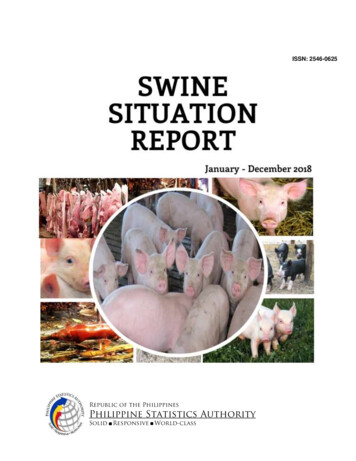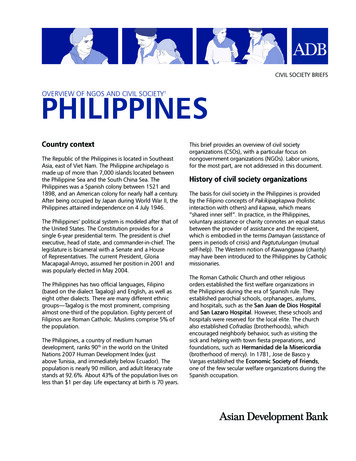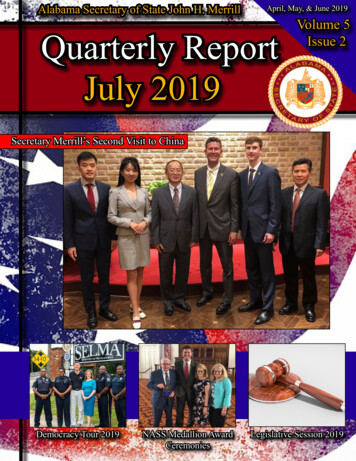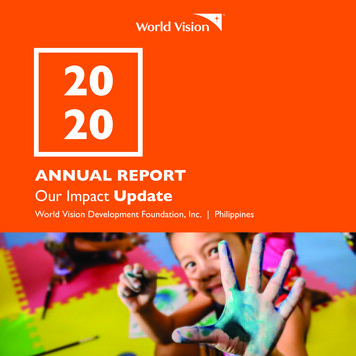
Transcription
2020ANNUAL REPORTOur Impact UpdateWorld Vision Development Foundation, Inc. Philippines
EDITORIALBOARDRommel V. FuerteNational DirectorXenia R. LegaspiDirector, OperationsAjab-Aram R. MacapagatDirector, Humanitarian and Emergency AffairsVanessa G. RetuermaDirector, Strategy Management Impact and LearningJun N. GodornesDirector, Resource DevelopmentZuzee S. AcederaDirector, FinanceGenesis Jeff D. LamigoManager, CommunicationsContent Contributors:Lanelyn Carillo, Mikhaela De Leon, Dexter Gamboa,Lara Gonzales, Mong Jimenez, Joy Maluyo,Ralph Joseph Peñaojas, Deivid Rioferio,Laila Soliven, Margaux Tan and Krizia VegaArt Direction and Layout:Margaux Tan World Vision Development Foundation 2020All rights reserved. No portion of this publication may be reproduced in any form, except for brief excerpts in reviews, withoutprior permission of the publisher.About the Cover: A week after the Taal Volcano eruption, children gather in World Vision’s Child-Friendly Space to play, sing,dance, and draw together. Child-friendly spaces provide psychosocial support to children affected by emergencies and disasters.
TABLE OF CONTENTS4Message from the Chairperson5Message from the National Director6About Us8Education10Health and Nutrition12Humanitarian and Emergency Affairs16Savings and Livelihood17Faith and Development18Child Protection20Financial Summary22Board of Trustees23Leadership Team24Partners26AccreditationsWorld Vision’s hand washing projects make watermore accessible in remote areas in the Philippines.
Message from theChairpersonWorld Vision, during its Day of Prayer, jumpstarted the fiscal year 2020 with theinspiring Bible verse “Go further than we can ever ask or imagine through God’spower that is at work within us” (Ephesians 3:20).Chief JusticeReynato S. Puno(ret.)Indeed, the pandemic that followed COVID-19 compelled us to depend on God’ssupernatural powers and enabled us to accomplish miraculous achievementsbeyond our expectations.In November 2019, the Philippines hosted the World Vision Triennial Council inManila attended by more than 400 World Vision leaders from around the globe.Little did we realize that a physical gathering of that scale may never be replicatedin the next years given the global health emergency.In the year 2020, we were devastated by natural catastrophes such as the Mindanao earthquakes, Taal Volcano eruption,and the long-running COVID-19 pandemic.World Vision had to adjust realign its priorities and pivot current programmes to ensure that we relevantly address theneeds of the most vulnerable amid the extensive health crisis.Though separated by quarantine restrictions, we remained one for children as we worked together to protect theirrights and address the most urgent needs.The events of 2020 pushed us to go further in strengthening our collaboration with government agencies and healthsystems and in forging new partnerships with the corporate sector, churches, ambassadors, communities, and the youth.One of the highlights of our work this year is our partnership with the Department of Education (DepEd). In June 2020,we were given the honor to support DepEd’s Learning Continuity Plan, which aimed to deliver quality and accessibleeducation at all levels. Through World Vision’s Abutin Na10 project, we are able to contribute to DepEd’s goal ofdistributing self-learning materials that will aid students during the pandemic and provide long-term solutions to thecurrent gaps in education in the country.We went further in empowering children by giving them platforms to talk about issues that concern and affect them.In the World Vision Summer Shoutout, a global virtual conference, Jomarie, a youth leader from Luzon, shed light on thefears experienced by children because of the pandemic. With the knowledge he gained from his personal experiencesand the trainings he received from World Vision, Jomarie called on parents, guardians, adults, and leaders to activelyprevent violence against children.Through all these, the goal remains the same: To give every child a chance to live life in all its fullness, as intended by theLord. Thank you for taking this journey with us. May the accomplishments listed in this report inspire every one of usto keep going further for the future of our children and for the glory of God.4
Message from theNational DirectorI am the vine, you are the branches; he who abides in me and I in him, he bears much fruit, for apartfrom me you can do nothing. - John 15:5Truly, His great love enables us to bear much fruit that glorifies Him.Rommel V. FuerteIn 2020, we have experienced a handful of daunting natural events --- Taal Volcano eruption,Typhoons Goni (Rolly) and Vamco (Ulysses), and the dreaded COVID -19 pandemic. As arelief, development, and advocacy organization focused on children, World Vision in thePhilippines faced its most challenging, if not uniquely massive, response effort to help millionsof vulnerable children affected by the successive calamities.By God’s mighty hand and grace, World Vision despite the overwhelming hurdles brought by multiple emergencies, has reached about 5.8million individuals through our child-focused advocacies and humanitarian response.Our prior commitment to reach the urban and more fragile areas has led us to roll-out project sites in new areas across the countryincluding the Quezon City Area Programme (AP) in Luzon, Mandaue City AP in Visayas, and two projects in Marawi and Cotabato Cityin Mindanao.In the aftermath of two recent and strong typhoons, World Vision has so far assisted over 27,000 affected people, nearly half are children,living in the hardest-hit provinces of the Bicol and Northern Luzon regions.Months after we started the COVID-19 Emergency Response in the Philippines, we have reached over 5 million people through provisionsof health and hygiene kits, food assistance like tons of fresh vegetables, huge tents and protective equipment among others for publichealth units and frontliners, and distribution/broadcast of informative materials to communities so they can be well-informed. We evenprovided fun board games and storybooks written and designed for children to be engaged and cope we stressful situations.The past year might be deemed unprecedented for most of us, but the enduring stories of transformation told by children, our communitypartners, and even of our own staff and supporters, drive us to remain hopeful and faithful to Our Promise of serving the most vulnerable.One compelling story is that of 17-year-old Jayson, a sponsored child and one of our child leaders living in Manila, who participated in theAsia Pacific Child Well-Being Learning Exchange. During the forum, he stood out as a voice for children to encourage his peers, adults andthe government panel to listen to them as they raise their concerns and recommendations on their welfare amid the pandemic.Another story is about Salwah, 15, of Lanao del Sur, who became part of World Vision’s Marawi Peace and Protection project which aimedto empower her and thousands of fellow children and youth to strengthen systems and structures to build a culture of peace, especiallyin the armed conflict-stricken city of Marawi and neighboring provinces.She says, “I am usually shy but being a peace advocate and a youth facilitator for peacebuilding activities compels me to step up. I shoulddo it because I want our generation to be peace-loving,” she shared.Our current and former sponsored children have grown to become important contributors in the field of public service, the academe,business, health care, the church and many more.We may have seen problems due to the pandemic, but we have also seen caring and good-hearted people and groups, partnering with usto bring hope, joy and peace to the least and the most vulnerable of our people.With that, we can only be more inspired and grateful.From all of us at World Vision, we deeply thank you for the opportunity to serve. May God bless us all!
World Vision is a global relief, developmentand advocacy organization dedicatedto one purpose: to give every child thechance to enjoy life in all its fullness.Our work in the Philippines began in 1957,where we initially assisted 300 childrenfrom an orphanage in Guimaras. Today,we work with supporters, stakeholders,families and communities on the groundto transform lives and bring hope. Ourcommunity-based development programsfocus on ensuring children get qualityeducation, enjoy good health, experiencethe love of God and their community andare cared for, protected, and participating.In 2020, 39.2 million children, 5.8 millionof whom are vulnerable, benefittedfrom five national-level child well-beingpolicies influenced by World Vision.Of these, 254,439 children directlybenefitted through sponsorship, technicalprograms, special projects, local advocacyinitiatives, and emergency response. Weare privileged to serve and work to seerelationships restored and communitiestransformed, all as a reflection of God’sunconditional love. And, we humblyacknowledge that without the goodnessof God and the generosity of donors, wewould not be able to do what we do.39.2 million children benefittedfrom 5 national-level child well-beingpolicies influenced by World Vision254,439 childrendirectly served throughchild-focused interventionsIn celebration of the 30th anniversary of the United Nations Convention onthe Rights of the Child (CRC), and the 27th National Children’s Month, WorldVision organized a three-day national children’s congress, attended by morethan 140 children across the Philippines.6
Where We Serve28 provinces, 18 cities, 91 municipalitiesPangasinanMalabonCamarines NorteQuezon CityCamarines SurManilaAlbaySorsogonBatangas 1Catbalogan CityBatangas 2SamarHaven of Rest 2Aklan 1Leyte 1Antique 2Leyte 2Antique 3North CebuNegros OccidentalBohol NortheasternHimaya 2Bohol 3Dipolog CityMarawi CityZamboanga del NorteBukidnonWest MisamisNorth CotabatoLanao del NorteMaguindanaoLanao del SurSultan KudaratCotabato City7
EDUCATIONQuality and accessible education opens countless opportunities for children, especiallythe most vulnerable. However, in a recent evaluation of World Vision covered areas, datashows that only 69% of the school-age children achieved at least a minimum proficiencylevel in reading and this may be exacerbated by the impacts of the COVID-19 pandemicon children’s learning. The COVID-19 pandemic prompted the Philippine government tosuspend classes and close schools, affecting millions of learners all over the country. Thefollowing school year also suffered a decline in enrollment as families faced economic andaccessibility challenges that hindered learners from attending class.To help more children have better access to quality education even during the pandemic,World Vision strengthened its partnership with families and communities, the local and nationalgovernment and the private sector. We continued to complement the government’s effortsto improve learning outcomes with “Brigada Pagbasa,” a project that brings together experts,changemakers, policymakers, and other stakeholders to spread reading literacy among Filipinochildren. As part of this initiative, we also launched “Abutin Na10, Para sa Sampung MilyongMag-aaral: Sampung Piso, Sampung Araw, Sampung Milyong Filipino,” a fundraising campaignaimed to support the education agency’s learning continuity plan through the production and distribution of learningpackets and activity sheets.Through ProFuturo, an innovative digital education programme promoted by Telefónica Foundation and “la Caixa”Foundation, we continue to help reduce the educational gap by providing schools with digital education tools thatcan be used online and offline. Learning resources cover literacy, science, technology and math, and digital andcommunication skills.Aside from providing learning materials, we also held webinars on Facebook, YouTube and Zoom to empower learners,parents and teachers as they navigate through the “new normal.” With these interventions, World Vision hopes toequip children and their families and communities with the tools and mindset to finish their studies.ChosenIn 2019, World Vision invited people across the United Statesto sign up and be chosen by children to be their sponsors,ultimately giving the power to choose in the child’s hands.In 2020, World Vision in the Philippines joined this globalmovement, and gave Filipinos the opportunity to be chosenand be part of the life-changing journey of child sponsorship.It is our hope that through Chosen, more children will beempowered to make a difference in their lives, knowing thatthere are many who support and care for them.8
86,309 children reached through various education interventionsContributing Programsand ProjectsEducation Technical ProgramING Learning Center ProjectPro Futuro Digital EducationProjectEvery Child A Reader andNurtured (EARN) ProjectAuto Mechanic TrainingCentre ProjectNATCH Scholarship ProjectClassroom ConstructionProject in OrmocanayElementary SchoolSecure, Accessible, andFriendly Educational (SAFE)Classrooms ProjectConstruction of OneFurnished School LibraryBuilding Project63,118 children receivedback-to-school kits24,067 registeredlearners trained on and activelyusing digital learning platform2,346 students accessedimproved school facilitiesand equipment i.e. classroom,library, learning and localreading materials, printers,television, etc.33 out-of school youthgraduated with NC-IV levelcertification in auto mechanicsSchool Repair andImprovement Project24,544 childrenparticipated in life skillsdevelopment activities2,434 childrenreceivedremedial support includingtutorial1,907 teachers trainedon teaching methods toimprove education qualityincluding digital education28 schools assistedwith chairs, tables, gendersegregated toilets, LED TVs,printers, books and otherschool equipment essentials4 college studentsCOVID-19 EmergencyResponseprovided withscholarship grantNexi remains determined even aftershe did not receive her valedictorianaward face-to-face due to thepandemic. “I want to study well sothat I can be an engineer someday.”9
HEALTH AND NUTRITIONChildren cannot reach their full potential when they are not healthy. Likewise, theybecome more at risk of diseases when their bodies suffer from malnutrition. In a recentevaluation of World Vision covered areas, data shows that 26% of children under5 years old are underweight; 42% are stunted; and 15% suffer from wasting. Thesenumbers are way above the WHO global standards for underweight (10%), stunting(20%), and wasting (5%), respectively. In support of Sustainable Development Goals 2and 3 and the Philippines’ Development Plan to improve nutrition and health for all,World Vision prioritizes programs that would ensure that children and their familieseat nutritious food, have access to clean water, and enjoy quality health services.In 2020, World Vision successfully taught parents and caregivers proper and practicalfeeding, health, and hygiene practices. We rehabilitated 112 underweight childrenthrough the Positive Deviance/Hearth approach. Likewise, we continue to informparents and nutrition personnel about the importance of exclusive breastfeeding duringthe first six months of an infant’s life by spreading awareness about the Philippine MilkCode through the First 1,000 Days project.Roots to ShootsWorld Vision partnered withPilipinas Shell Foundation andManila Water Foundation tocurb malnutrition in CamarinesSur through food security, water,sanitation and hygiene facilities,and breastfeeding awareness. By facilitating capacity trainingsfor farmers, providing infrastructure support, and focusing on nutrition and mother and child care education, wehope to provide a holistic approach that can help children be protected from health threats and hazards.Virtual Run for Children 2020The community quarantine may have kept people apart, but it did not keep them from being One for Children. FromJune 15 to July 31, hundreds of runners participated in World Vision’s first ever Virtual Run for Children to advocateand raise funds for children while staying active during the pandemic. Proceeds of the run were used to providehygiene kits and back-to-school kits to children.10
112,213 children 0-17 years old reached through various health and nutrition interventions321 underweight children rehabilitatedContributing Programs and ProjectsHealth and Nutrition Technical Program29,253 children provided with foodClean Water Phase 3 Project30,731 individuals including childrenGender-based WASH for Emergencies ProjectCreating a Sustainable School-based Solid WasteManagement Program in the Philippines (a.k.a. Pagasa Sa Basura) Projectpacks, vegetables and micronutrient powderreceived hygiene kitsHandwashing Facility in Cabugao ElementarySchool Project2,132 parents/caregivers trained on infantIntegrated Action for Children’s Nutrition(INTERACTION) Projectand young child feeding practices to preventand manage malnutrition and on early homedetection of acute malnutritionIntegrated Nutrition and Health Actions in theFirst 1,000 Days ProjectJohnson & Johnson ProjectRoots to Shoots Project67 health and nutrition personnel trained onNutrition Sensitive CoMSCAPlantsville ProjectEO51 or the Philippine Milk CodeTrash To Treasure Project12 LGUs integrated EO51 in their LocalMarawi Peace and Protection Phase 2 ProjectCOVID-19 Emergency ResponseNutrition Action Plans for monitoring andimplementation of Milk Code149,922individuals (90,725 adults and59,197 children) reached with WaSH programs61 WaSH facilities including gender-sensitivetoilets and handwashing facilities installed in 13schools benefitting 2,248 studentsMindanao Earthquake ResponseTaal Emergency ResponseTyphoon Kammuri Emergency Response16,656households provided with safe drinkingwater, purifying packets and water kits22,078on WaSH11children provided with IEC materials
HUMANITARIAN ANDEMERGENCY AFFAIRSEvery child deserves to stay safe, play, and grow in communities that are ready andresilient to natural and man-made disasters and emergencies. As contribution to thePhilippines’ development plan to reduce the vulnerabilities of individuals and families,World Vision aims to improve the resilience of communities to disasters.Mindanao EarthquakesIn the last quarter of 2019, Mindanao was hit bya series of earthquakes with magnitudes spanningfrom 6.3 to 6.9, forcing thousands of people intoevacuation centers, disrupting the classes of millionsof learners, and damaging houses and infrastructures.Complementing the government’s emergency effortsin the region, World Vision distributed non-fooditems, hygiene kits, jerry cans, and emergency shelterkits. We also set up temporary learning spaces wherechildren could get psychosocial support. World Visionreached 2,232 families or 10,066 individuals during therelief phase and 11,975 families or 43,736 individuals during the early recovery phase ofour response to the Mindanao earthquakes.Typhoon KammuriFollowing the destruction by Typhoon Kammuri (local name Tisoy) in December2019, World Vision provided hygiene kits and emergency shelter kits to 1,320families to complement the government-led relief operations. Kammuridestroyed thousands of houses in its wake, leaving children and families homeless.12
Taal Volcano EruptionTo address the needs of the people affected by Taal Volcano’sunrest in January 2020, World Vision immediately went on theground to give away emergency essentials such as hygiene kits,non-food items, dust masks, and drinking water. Child-friendlyspaces were also built to help children cope from the distresscaused by the unrest through games, music, and art. Through theresponse, we reached 5,435 families or 68,958 individuals, 43,417of which are children.Marawi Peace and Protection ProjectLaunched in 2018, World Vision’s Marawi Peace and Protection Projectengaged children and youth in various activities that promote peacebuilding. The project aimed to help strengthen systems and structuresfor peace and protection and to empower children and the youth tobecome agents of peace. The project covered barangays in Marawi andLanao del Sur and trained hundreds of participants including barangayofficials, teachers, and youth leaders.62,476 families in MarawiCity benefitted from a total of 1,874metric tons of rice from World VisionTaiwan turned over to DSWD1,040 upcycled school chairswith safety dividers (from thecollected 3.2 million pieces ofsachets and 900,000 bottles inschools) donated to partner schools2 communities received equipmentfor recycling39 community members trainedas responders (basic first aidtreatment, rescue and water search)5,937 community membersincluding students increasedknowledge on proper wastemanagement and recycling practices37 schools with functionaland strengthened solid wastemanagement (SWM) committeeContributing Programs andProjectsEducation Technical ProgramMarawi Food (Rice) AssistanceProjectResiliency Improved forSustainability and Empowerment(RISE) ProjectCreating a Sustainable Schoolbased Solid Waste Management(a.k.a Pag-Asa sa Basura) ProjectTrash to Treasure ProjectCOVID-19 Emergency ResponsePHINLA Project
COVID-19World Vision launched its global COVID-19 Emergency Response as the pandemic began to threaten the lives ofchildren and families across the world. Spanning 70 countries, our response is guided by four strategic interventions:scaling up preventive measures to limit the spread of COVID-19 in families and communities, strengthening healthsystems and workers, supporting children impacted by COVID-19 through education, child protection, food security,and livelihoods, and collaborating and advocating to ensure vulnerable children are protected.In the Philippines, our COVID-19 response covered 24 provinces, 19 cities, and 43 municipalities. Guided by ourstrategic interventions, World Vision partnered with communities, government units, and the private sector toensure that the response will reach as many families as possible.To limit the spread of COVID-19, we focused our efforts on spreading information on infection prevention and controlthrough online and traditional means, and distributing hygiene and sanitation kits to families across the country. Wealso provided tents, disinfectant kits, and personal protective equipment to medical frontliners, and supplementaryfood to children in order to support health workers and local health units.As a way to support children whose education, safety, food security, and economic stability were severely affected bythe pandemic, World Vision integrated the implementation of the COVID-19 emergency response to our programmes.We also actively collaborated with key stakeholders such as celebrities, corporate partners, students, and churchesto advocate for the rights and protection of children amidst the pandemic.14
15
SAVINGS ANDLIVELIHOODCharmaine’s family is able to benefit from World Vision’s community-focused programs like nativechicken raising.Families with sustainable sources of income are more capable to support their childrenfor the long term. To complement the Philippine Development Plan that aims toimprove the employability and income-earning potential of individuals, World Visioninvolves parents and caregivers in economic development interventions that will equipthem with the knowledge, skills, and livelihood opportunities that will enable them toprovide for their families and build sustainable communities.However, because of the pandemic, sustainable sources of livelihood were disrupted,affecting the ability of families to provide the most basic needs of their children. Toaugment the need for a steady stream of income and promote alternative livelihoods,World Vision offered agricultural inputs and assets like vegetables seedlings,gardening tools, and natural fertilizer, which families could use for backyard gardening.Entrepreneurial support and skills trainings were also provided.Moreover, we promoted financial literacy and financial management to communitymembers and their children through the Community-Managed Savings and CreditAssociation (CoMSCA), which benefitted thousands of members through savingsgeneration and loan availment.16
Contributing Programs and ProjectsEducation Technical ProgramAiding Vulnerable Communities through ValueChain ProjectCommunity-based Aquaculture ProjectPHINLA ProjectPlantsville ProjectCommunity-Managed Savings and CreditAssociation (CoMSCA)78,033 individuals supported forlivelihood improvement through the provisionof agricultural inputs/assets, waste collectiontools and equipment, and training onentrepreneurship, financial literacy and wastemanagement59 youth trained on values formation,entrepreneurship and financial literacyCOVID-19 Emergency Response5,894 community membersreached by campaigns about incomegeneration from wastes and wastemanagement27 waste collectors becamemembers of Waste Collectors’Association formed by World Vision2,259 organized savingsgroups with 31,057 membersincluding 996 Kids’ CoMSCAmembersCoMSCA is a savings mechanism with more than a hundred thousandmembers all over the country.
FAITH AND DEVELOPMENTIn a recent evaluation of World Vision covered areas, data shows that, on the average,72% of boys and girls age 12 to 18 years old have positive and peaceful relations withtheir parents/caregivers, peers and faith leaders. With the aim of increasing this baselinedata, World Vision actively partners with churches, faith-based organizations, parents,guardians, and children to consistently promote spiritual nurture and positive valuesamong children and the youth through our Spiritual Nurture for Filipino Children(SNFC) project.Recognizing that the church plays an important role in giving psychosocial aid to familiesin the midst of the COVID-19 crisis, we put together a series of training webinars anddistributed brochures to help church workers provide Christ-centered support andwellness for their community members during the pandemic.Songs of HopeIn 2020, we worked closely with churches and worship groups such as Christ CommissionFellowship (CCF) Exalt Worship, Favor Church, Living Word Churches, Union Church of Manila,Victory Worship and Victory Christian Fellowship (VCF) Katipunan, and artists such as OgieAlcasid, Christian Bautista, Clara Benin, Tippy Dos Santos, Rommel and Susan Guevara, SittiNavarro, Inigo Pascual, Joyce Pring, Perkins Twins, Quest, and Janina Vela for “Songs of Hope,”an online benefit worship concert aimed to raise funds for our COVID-19 emergency response.97,577 children reached throughspiritual nurture activitiesContributing Programs andProjectsEducation Technical ProgramSpiritual Nurture for FilipinoChildren (SNFC) Project145,295 parents/caregivers trained on responsibleparenthood and the importance of spiritual nurture for children36 children andyouth developedan IEC material onspiritual nurturefor children18109 schoolsadopted spiritualnurture for childrenin their schoolimplementation plan25 church and FBOrepresentatives completeda certification trainingprogram for churchleaders on self-care andpsychological first aid
CHILD PROTECTIONGlobally, World Vision has committed to end violence against children by addressing countryspecific issues that threaten children today. In line with the Philippine development plan toreduce the vulnerability of individuals and families, we continue to be part of child protectioninitiatives that would ensure that children are protected from any form of harm and abuse.The COVID-19 rapid assessment report World Vision conducted in the Philippines revealedthat children have become more vulnerable to child labour, online sexual exploitation,physical violence, and emotional stress. To help parents and children cope, we distributedinformation materials containing key messages on protection, positive parenting andpsychosocial support. The materials came along with other interventions such as theprovision of health kits and relief goods to affected families.As part of Joining Forces Philippines, World Vision, together with ChildFund Alliance(including Educo), Plan International, Save the Children, SOS Children’s Villages, and Terre desHommes, also calls on the government to strictly implement laws and programs concerningthe protection of children. Additionally, World Vision pushes children and families to remainempowered in preventing violence against children by raising awareness and strengtheningreporting mechanisms in communities.In September 2020, World Vision also launched Project Against Child Exploitation, aninitiative funded by the United States Department of Labor (USDOL) that aims to supportthe government’s efforts to combat child labour in the Philippines. Through collaboration, the project intends to improvethe enforcement of child labour laws and policies, improve assistance for child labourers, and strengthen partnershipsfocused on these issues.66 (100%) reported childprotection cases responded10,854 student/childleaders actively campaignedabout child protectionand promoted peacefulrelationships22,078 children providedwith IEC materials on childprotection, psychosocialsupport and Christian Care1,048 child laborers oriented onchild rights and child labor traffickingprevention2,539 parents/caregivers trainedon child protection including genderawareness for childrenContributing Programs and ProjectsCommunity Engagement and SponsorshipProgramMarawi Peace and Protection Phase 2 ProjectChild Protection Compact ProjectCOVID-19 Emergency Response2,057 stakeholders (FBO, BCPC, schooladmin, social workers, Community WatchGroups) trained on the prevention of child labortrafficking and online sexual exploitation ofchildren19
Where Our Resources Go6%Revenue Sources14%International Private Cash Contributions59%21%PhP 527 MLocal Private Cash Contribution193 MCorporate Donors122 MGovernment and Multilateral Grants57 ME
4 Message from the Chairperson 5 Message from the National Director 6 About Us 8 Education 10 Health and Nutrition 12 Humanitarian and Emergency Affairs 16 Savings and Livelihood 17 Faith and Development 18 Child Protection 20 Financial Summary 22 Board of Trustees 23 Leadership Team 24 Partners 26 Accreditations TABLE OF CONTENTS World Vision's hand washing projects make water
